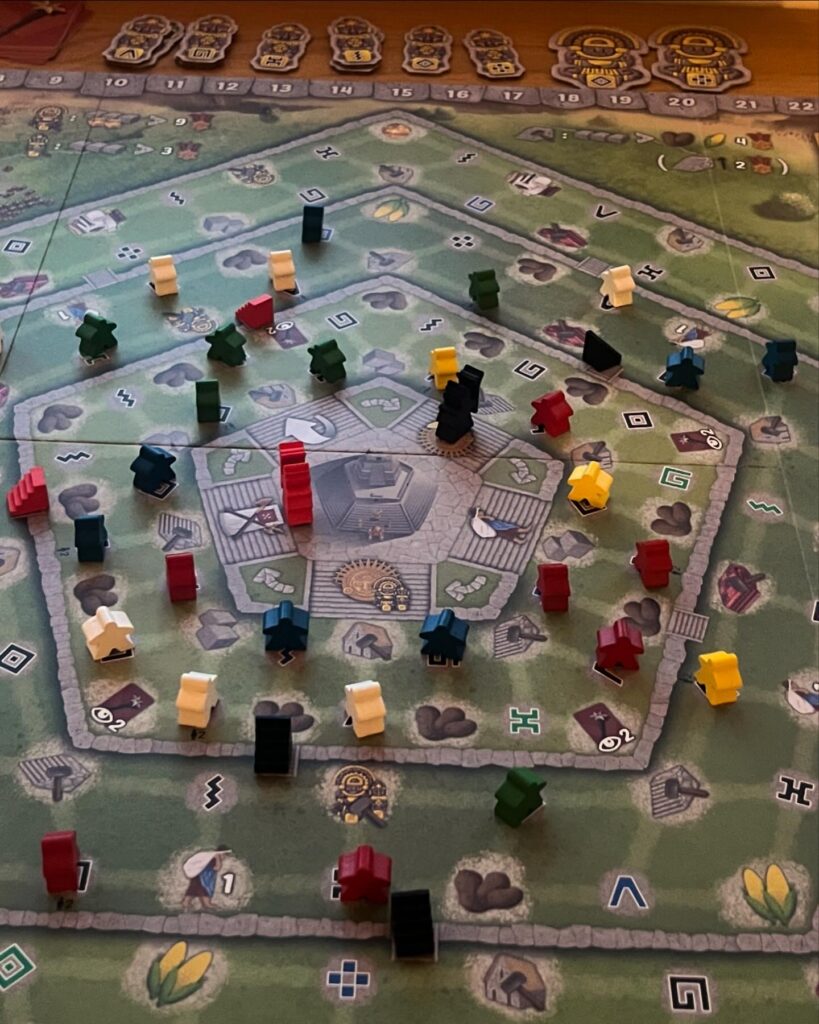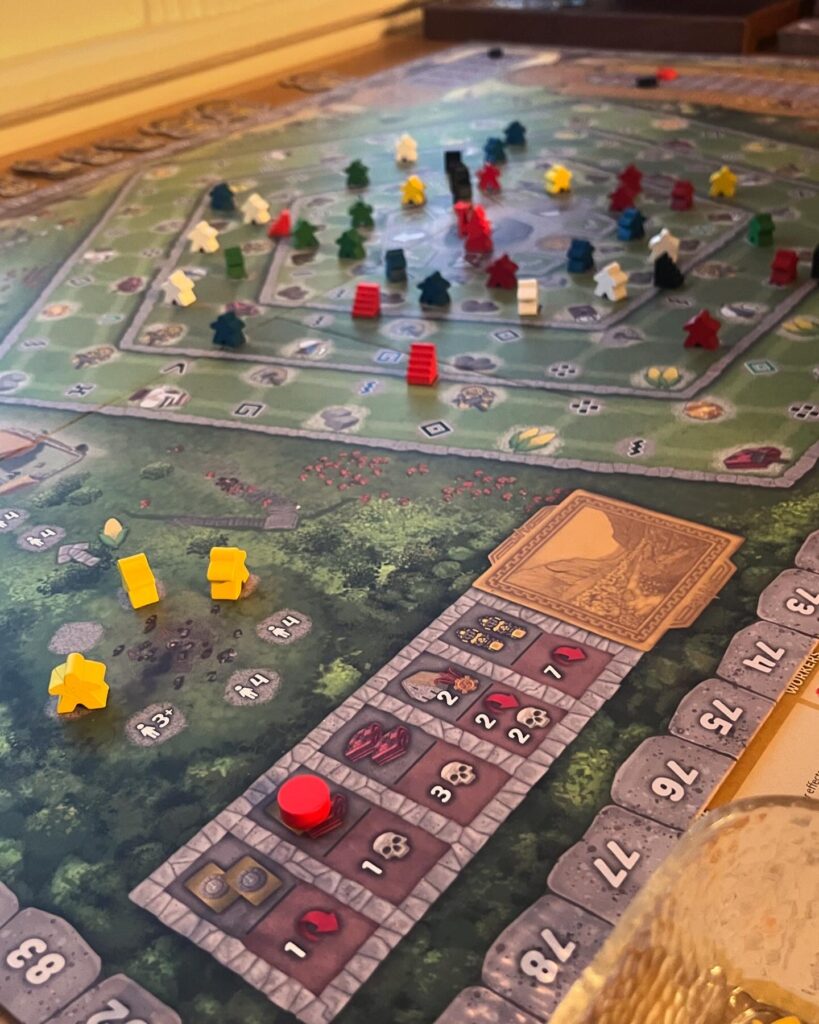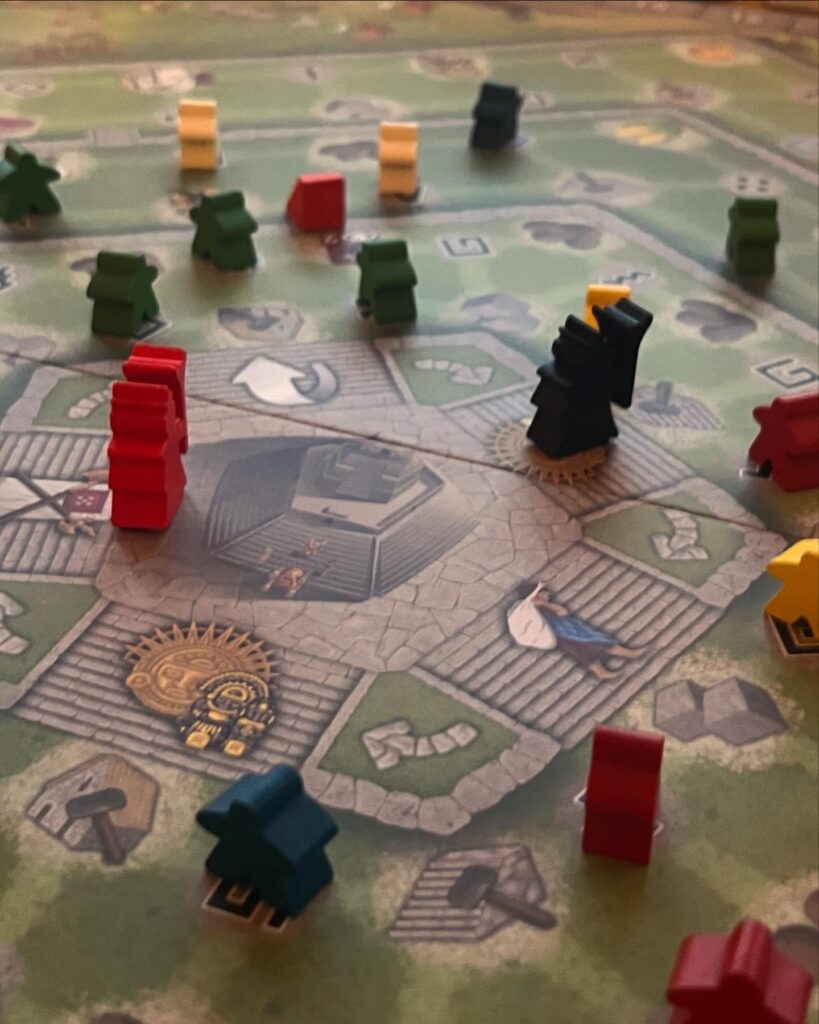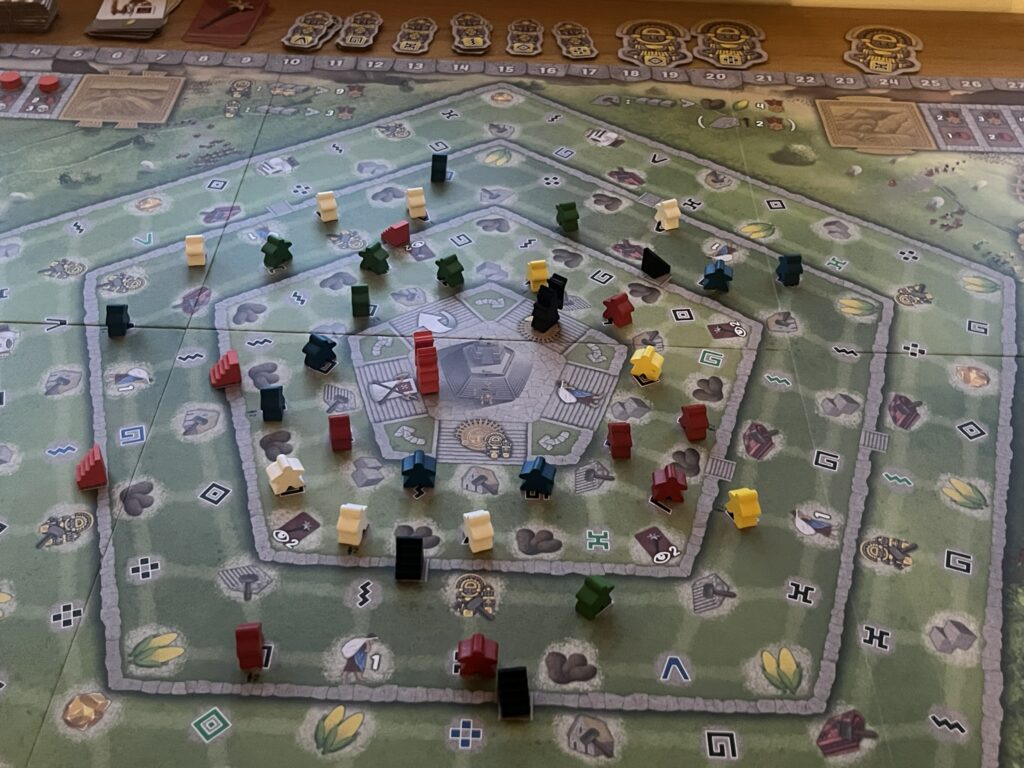Ascend to the golden temple in this multi tiered worker placement puzzle for the gods. Don’t you want your potato?
Designed by David Turczi Tawantinsuyu: The Inca Empire casts players as the competing offspring of the emperor Pachacuti. Each of whom is seeking to gain the most fame and influence while demonstrating the most piety (all of this amounts to victory points of course) to cement themselves as the most worthy successor at the end of the game.
Tawantinsuyu: The Inca Empire is at its core a worker placement game with a multitude of surrounding and interlocking systems. There are easily a dozen different ways to accrue victory points and it would be impossible to make a good job of pursuing them all (or cover them all in a review of reasonable length). Tiwantinsuyu is played in continuous rounds broken up by three festivals (interim scoring) with game end scoring immediately following the third festival.
On their turn players can choose between either placing a worker or taking two (very important) secondary actions. The board is dominated by a central five sided hill divided into terraces in the Inca fashion offering numerous worker placement spots. At the pinnacle of the hill is the five sided Coricancha which functions as a rondel occupied by your high priest meeple. Each of the worker placement spots features one of six god symbols and is adjacent to several action icons. In order to place a worker on a given spot players will need to discard a matching god card from their hand (or pay a gold resource) in addition there are resource costs for some placements to consider in the form of roaming and descending. The roaming cost is determined by the current position of your high priest on the temple rondel. All placements on the same side of the hill incur no roaming costs while placing in an adjacent section costs one food (corn or potato) deploying a worker beyond this costs three food. Now we have the descending costs to think about which represent the effort of moving up and down the hill with goods. The highest and innermost terrace is free while the second and third tier cost progressively more. Descending costs can be reduced by spending stone to build stairs between terraces. Stairs will earn points and resources when you construct them and also a single point when other players travel on your stairs. So now we know where our worker is going, what happens when they get there? Well that depends on the type of worker (stay with me).
In Tawantinsuyu player don’t have their own workers in their player colour as in many games. Instead different worker types are acquired from the shared village and nomad areas. The worker types available are randomised and refreshed after the first and second festival. Each of the five worker types have an ability that triggers when placed. Blue craftsman gain an additional action when placed on blue symbols, white priests allow you to draw a god card and pay a potato for an additional action while red warriors allow you to return an adjacent worker of a different colour to your hand. Workers gain one additional action for each adjacent worker of the same type. So clever placement can often get you a couple of actions or even more if you are a master planner.

After negotiating all these decision spaces what sort of actions might your worker get? Well there are the usual resource gathering spots, you may build stairs or a building (there are two types-some have to be activated the others offer always on passive benefits), perhaps build a statue (which grant you bonuses from matching god cards when you place workers) to honour the gods or weave some tapestries.
The main secondary action allows players to move their high priest around the central rondel activating one of five possible actions. Players might initiate a conquest which allows them to spend army cards for one time rewards in one of four zones which are also scored based on area control, trade in statues to advance on the temple track for bonus resources and festival scoring, give an offering of corn to the gods or rejuvenate (flip face up) used buildings and army cards. When one of these secondary actions is triggered all other players get the option to perform a weaker version of the same action. For example f the active player takes a offering action they may move up to three spaces on the temple track, following players may choose to move just one at a greater expense.

The other secondary actions offer some much needed simplicity. Players can draw army and god cards or recruit an available worker for free. At the end of their turn players also have the option to purchase one of two possible workers from the village but they may not have more than two workers at the end of their turn.
Clearly there’s a lot of interlocking parts here, but is this puzzle much fun? Tiwantinsuyu challenges players to chart a course among an almost overwhelming number of options, I found that trying to do a little bit of everything led to a slow trickle of points and eventual defeat. Scaling the heights required careful planning and laser focus on a few of the scoring options, often the ones your opponents are neglecting.
The placement of every worker offers multiple possibilities and it’s often possible to benefit from an opponents action by leveraging worker adjacencies. Conversely you need to be wary of aiding a rivals designs with your placements which makes for enjoyable tension with every placement. There’s a lovely escalation to the gameplay as the available placement spots fill up and players work outwards down the terrace. The placements become more powerful and satisfying as adjacencies inevitably build up as does the smug factor from triggering multiple actions. However with so many options to optimise you may find yourself suffering from analysis paralysis, or facing the temptation to check your phone while others run the numbers as they decide what to do. After the first few games we agreed on a turn timer to keep things running smoothly.
Learning how to maximise the central rondel was a fun challenge. To have any hope of victory every movement needs to be maximised but you also need to watch your opponents as being prepared to piggyback their actions can help you creep towards victory rather than fall behind. You will constantly be balancing advancing on the rondel with getting the most bang for your buck from worker placements. I loved trying to anticipate my opponents rondel actions and working to have just the right resources at the right time.
There is no direct player interaction, however the brilliant rondel mechanic and persistent worker placement together with the area control of the conquest area all mean you have to keep a close eye on what other players are up to rather than just collecting your points in a bubble as in some euros.
As I’ve mentioned there are lots of different ways to score some of which I enjoyed more than others. I loved racing up the temple track and the conquest system, however the tile collecting mini puzzle of the tapestries didn’t appeal as much but some may love that. With so many established euro game concepts on show here there’s bound to be something that resonates for everyone and with so many familiar mechanics presented at once there is a steep but manageable and enjoyable learning curve in Tawantinsuyu that really rewards once you build some momentum. You just might need to tap into your inner reserves of patience and be willing to write off the first game as a learning experience but it’s worth it.

With all those placement spots the board can look a little intimidating at first and so much iconography inevitably pushes the artwork into the backseat but the more you look the more detail emerges. The board does a decent job of depicting the setting but there are certainly other games with more table appeal out there. The conquest zones in particular are very functional. The component quality is nice with a stack of coloured wooden meeples and custom shaped resources (I can forgive the standard cube for stone), the cardboard building tiles are a decent thickness.
Overall Tiwantinsuyu is a compelling blend of many classic euro mechanisms which come together to form a multilayered puzzle with excellent replay ability due to its variety it just asks a little patience from players before it really gets going. It’s definitely an appointment game not something one just throws on the table. Players need to know what’s going on and have a few hours to spare or be willing to learn.
You can purchase Tawantinsuyu: The Inca Empire on Amazon.
Love board games? Check out our list of the top board games we’ve reviewed.
Comments are closed.